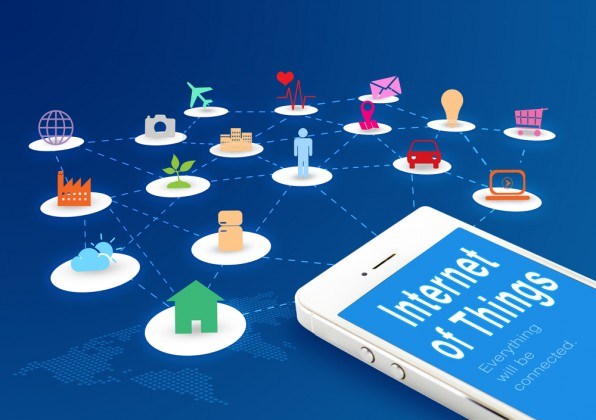
Let’s talk about ‘Internet of Things’ (IoT) today.
Term IoT has been coined by Kevin Ashton, a British technology pioneer. We can have a clear understanding of IoT through this quote by Ashton, from one of his published articles: “If we had computers that knew everything there was to know about things – using data they gathered without any help from us – we would be able to track and count everything, and greatly reduce waste, loss, and cost. We would know when things needed replacing, repairing or recalling, and whether they were fresh or past their best.”
IoT is just not a connection between computers, tablets, smartphones, etc.. IoT can make anything to be connected and communicated intelligently, making our physical world one big information system. IoT makes this possible by an IoT platform which enables secure communication from the devices/things attached to it. This IoT platform integrates data from these various devices/things connected to it and applies analytics to generate valuable information from this data. This analytics will be done using applications which can address industry-specific needs.
Going through real-life examples of IoT can give a clear understanding of it. Here we can see those examples :
1. Daily / Personnel applications
a) Wearables – These devices are installed with sensors and software to collect data about the users who are wearing them. Later on, this data will be processed to extract essential information about its user. These devices cover fitness, health and entertainment requirements. Pre-requisite for wearable IoT application is to be ultra-low-power and small-sized, at the same time.
Giants have invested heavily to invent wearable IoT applications due to the huge market demand. One example for wearable IoT devices is Cicret Bracelet.
b) Smart Home – The most popular application of IoT. This includes applications for enabling activities in homes (like switching-off lights even after leaving your home, switching-off A/C even before reaching your home, setting specific functions of home appliances like preheating the oven, etc.). Owning a home is the biggest investment in anyone’s life and smart home IoT applications make homes smarter.
Smart home IoT companies like Nest, Ecobee, Ring, August, etc. are on the way to become household brands by delivering exuberant experiences.
c) Smart City – One of the most interesting applications of IoT. Smarter energy management, urban security, waste management, transportation automation, etc. are coming under the applications of smart city IoT devices. Smart city IoT devices ease people’s lives.
Some of the examples are – installing sensors which use web applications to help people to find free parking space in the city and to find meter tampering as well as malfunctions in electrical systems, Cellular communication enabled ‘smart belly bash’ which can send alerts when a waste bin needs to be emptied.
2. Agricultural / Livestock management
Farmers can effectively cater to the world’s continuously increasing need for food by using smart farming. Sensing soil moisture/nutrients, controlled water usage, determining custom fertilizers, etc. are examples of smart farming IoT applications.
Livestock management in IoT includes monitoring applications which can gather data on the health condition of each of the livestock. This will enormously help in separating the sick one from the live stocks, preventing contamination, to generate efficiency.
3. Enterprise applications
a) Power Management – Smart grids in IoT is automated to collect data and analyze the behavior of power suppliers/consumers to improve efficacy in the usage of power. Smart grids in IoT can also do quick detection of power shortages at any unit, enabling utilization of distributed energy systems.
b) Industrial Internet – Also known as IIoT (Industrial Internet of Things). It can make industrial machinery smarter by the usage of sensors, softwares as well as big data analytics. This smarter machinery will be able to communicate using data, giving insights to companies on faster detection of malfunctions for preventing it.
Some of the major examples of IIoT applications are smart retail as well as smart inventory.
Smart retail applications connect to the consumers using smartphones even when they are out of the stores, detect consumer’s path while they are inside the store to improve store layout and product placement.
Smart inventory comes with applications to track goods, to exchange inventory-information among suppliers and retailers for enabling automated delivery in order to attain a highly efficient supply chain.
4. Other applications
a) Healthcare – Connected healthcare and smart medical devices possess enormous potential not only for organizations, but also for everybody in general.
Healthcare IoT collects data which can be used for personalized analysis of an individual’s health and provide tailor-made strategies to prevent/control illnesses. Thus, healthcare IoT can empower people on a healthy lifestyle by using connected devices.
b) Connected Vehicles – Connected vehicles are powered by IoT for optimizing operations, maintenance as well as passenger-comfort, via the usage of onboard sensors and internet connectivity.
The most revolutionary applications in this category of IoT is happening with cars. Major car brands like BMW, Tesla as well as IT giants like Google and some promising startups have made huge investments in R&D and are working on to make the next-generation IoT application in automobiles.
From all these factors, it is very clear that IoT can enable communication between billions of devices with the least possible human intervention. For sure, IoT is going to revolutionize information technology, and our lives, in the future.
